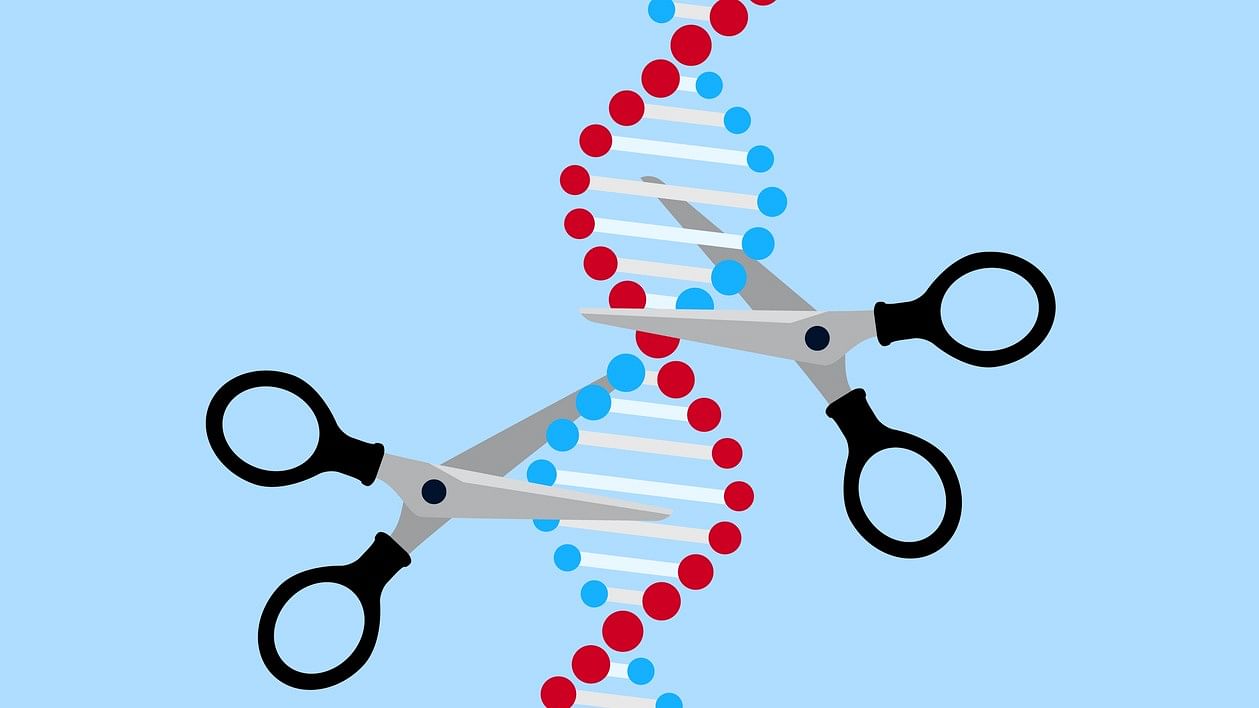
Advantages include precision, the ability to design variants tailored to needs, and optimal operational cost and time.
Credit: iStock photo
There are different types of biotechnology protocols for genome/gene editing (GE), but the preferred one is the Clustered Regularly Interspaced Short Palynodromic Repeat (CRISPR) Cas9 system. Advantages include precision, the ability to design variants tailored to needs, and optimal operational cost and time.
CRISPR was first identified in 1987 as a bacterial defence system against viral infections. The Nobel Prize-winning research (Chemistry, 2020) of Jennifer Doudna and Emmanuelle Charpentier (2012) provided a novel translational biotech protocol to ‘precisely target and cleave a specific DNA sequence’ in any living organism, facilitating its transfer to any other living organism.
Since then, CRISPR-edited biotech applications have revolutionised human welfare initiatives in healthcare (new medicines, treatment of viral infections, clinical diagnostics, cure of inherited genetic disorders such as retinal degeneration, boosting immunity, powerful DNA vaccines, etc.), agriculture (crop and livestock transformation for high yield, pests/parasite eradication), energy (bio-fuels), biodiversity conservation, and climate change. However, CRISPR applications in human reproductive biology could pose serious threats to human identity and social order if not handled with prudence.
The scope of CRISPR-edited biotech applications demonstrates that the ‘Biological Cellular Universe/Space’ is as enchanting and intellectually challenging as the external universe/space, contributing to our knowledge base and driving global industrial markets (corporate science) for socio-economic development. Yet, it has remained in the shadows of the physical sciences dominated technology ecosystem.
Interestingly, a publication database survey by P D Ramos and others in 2023 revealed low awareness of the impact of CRISPR among the general public. Communicating the importance of CRISPR and other global techno-science developments to stakeholders should be prioritised.
Increasing CRISPR capabilities in human reproductive biology have ignited intense ethical debates across the globe. The 2018 reports of the birth of a CRISPR-edited human child jolted and compelled intellectuals to take serious note of the adverse impact on biological human identity and ethical practices. A new era of bio-politics is upon us.
Ethical challenges: Techno-science developments such as AI, CRISPR, and their regulatory frameworks are in a perpetual arms race, with the latter more often lagging. The chances of maverick scientists attempting to transform human embryos with malicious intentions should be anticipated and prevented. The apprehensions of Oppenheimer, Neil Bohr, and Fermi (their discoveries in nuclear fission led to the making of an atomic bomb) are equally applicable to CRISPR-edited applications, including human babies.
At the heart of the ethical landscape is the precautionary principle invoked since 1970 for environmental threats due to genetically modified crop plants. Agricultural biotechnologists and environmentalists are engaged in heated debates about whether the principle is being applied excessively, stifling innovation and delaying human welfare, or whether it should be strictly enforced until all the safety concerns are addressed. Notwithstanding, 72 countries have accepted biotech crops, including the United States (71.5 million hectares), Brazil (52.8 million hectares), Argentina (24.0 million hectares), Canada (12.5 million hectares), and India (11.9 million hectares). The global agricultural biotechnology market is estimated to reach $110 billion by 2030.
The theoretical trajectories of ongoing research at the MIT Centre for Brains, Minds, and Machines on human brain-AI interfaces and the CRISPR-edited birth of a human baby seem to converge on the development of a human-like robot or robot-like human, with potential performance competencies surpassing human cognitive abilities. If realised, it would be one of the greatest ethical threats that humanity has ever faced.
Science philosopher and visionary C P Snow, in his book, The Two Cultures and the Science Revolution, called upon humanist studies to counter the ‘technologico-Benthamite’ culture, which misuses science in ways that cheapen, impoverish, and dehumanise life. According to Yoshua Bengio, extreme governance measures would be needed to prevent misadventures in AI. This is also true for CRISPR or any other technology with a potential threat to ethical practices.
Regulatory Landscape: WHO is set to create a Global Regulatory Framework to verify the science behind CRISPR applications and to regulate human gene editing. In the US, the Food and Drug Administration regulates gene therapy products through a risk-based approach, evaluating each therapy on a case-by-case basis to ensure that it meets rigorous safety standards. The European Medicines Agency and the National Medical Products Administration in China have established similar frameworks. Argentina, Canada, Brazil, Australia, South Africa, and Japan have also taken similar initiatives; a global consensus remains elusive.
In India, genetically modified organisms and their products are regulated by the Environment (Protection) Act (1986) and the “Rules for the manufacture, use, import, export, and storage of hazardous microorganisms, genetically engineered organisms, or cells (1989)”.
Harnessing the benefits of the techno-science revolution would be a meaningful mission only when its inherent fundamentalism is dealt with strongly by a robust policy framework with accountability and self-regulation legally assigned to all stakeholders.
(The writer is a former professor and registrar, Bangalore University)
(The writer is a former professor and registrar, Bangalore University)